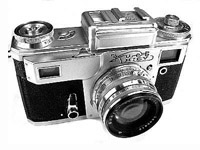
It's getting better!
4. "Kiev-4" camera shooting character
- Kiev-4
If you need Kiev-4 camera manual use this link. Here I share my experience of using the camera.
Page contents
- "Kiev-4" lens specifications
- Universal turret viewfinder
- Jupiter-8M lens
- Helios-103 lens
- Jupiter-11 lens
- Jupiter-12 lens
- Jupiter-9 lens
- Jupiter-3 lens
- Depth of field and focusing accuracy at max aperture
- Vignetting
Shooting character cannot be estimated without featires of lens you use. A good pack of them was produced for Kiev cameras.
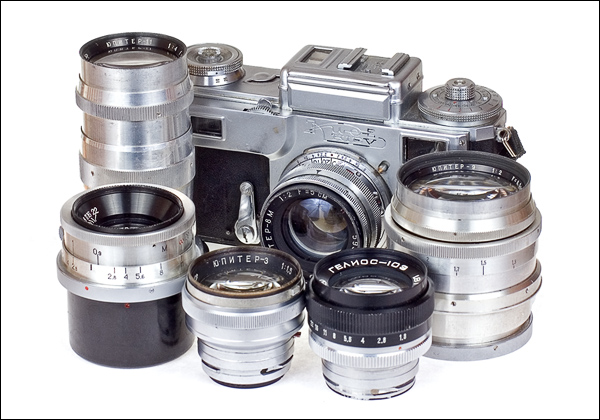
Thus, below you can see...
Table 1. "Kiev-4" lens specifications*
| Lens name | Focal length, mm |
Apertures range | Lens construction: elements/groups | Closest focusing distance, m | Angle of view | Resolution, lines per mm | Max. diameter x length, mm |
Weight, g | |
| center | edge | ||||||||
| Orion-15 | 28 | 1:6 - 1:22 | 4/4 | 1.0 | 75° | 45 | 18 | 59 * 37 | 78 |
| Jupiter-12 | 35 | 1:2.8 - 1:22 | 6/4 | 0.9 | 63° | 34 | 12 | 55 * 52 | 110 |
| Jupiter-3 | 53 | 1:1.5 - 1:22 | 7/3 | 0.9 | 45° | 30 | 14 | 48 * 42 | 160 |
| Jupiter-8M | 53 | 1:2 - 1:22 | 6/3 | 0.9 | 45° | 32 | 28 | 46 * 38 | 130 |
| Helios-103 | 53 | 1:1.8 - 1:22 | 6/4 | 0.9 | 44° | 55 | 28 | 47 * 45 | 150 |
| Jupiter-9 | 85 | 1:2 - 1:22 | 7/3 | 1.15 | 28° | 30 | 18 | 60 * 80 | 335 |
| Jupiter-11 | 135 | 1:4 - 1:22 | 4/3 | 1.5 | 18° | 34 | 19 | 55 * 93 | 290 |
*More detailed data about these and other USSR lenses (in Russian)
Universal turret viewfinder

If you use interchangeable lens with focal distance other than standard lens for Kiev-4 have (Jupiter-8M и Helios-103), you have to use universal turret viewfinder. For example, one shown on fig.2.1. It is mounted into the outer accessories shoe. This made shooting process much more sophisticated. First, focus the lens using the rangefinder, then choose frame borders using the turrer viewfinder and only after that you may press the shutter release button.
However, at the second step you may encounter typical rangefinder cameras problem. If the lens has long focal distance and is used
for shooting objects at the distances 10 m and closer you need necessarily to take into account vertical parallax between optical axes
Parallax does not affect much if you shoot using Jupiter-12 lens, and you don't need to take care of it even for minimal shooting distance. But as far as telephoto lens Jupiter-9 and Jupiter-11 are concerned it is recommended to shoot several test shots to get familiar with cases when you should take care of frame borders.
Now it is time to go from common words to lens properties.
Jupiter-8M 1:2 f=53mm
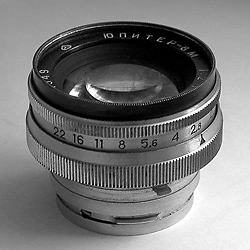
Apertures wider than f/5.6 give poor resolution in distant openwork object images, so, you need to close the aperture for such scenes.
There is opinion that Jupiter-8M is the inferior copy of original German Sonnar lens which was prodused in the USSR as Jupiter-8 (without "M").
Is this true or not - I have had no chance to check out. I only know that Jupiter-8 aperture changes smoothly and
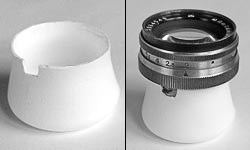
One of the most popular problems with this lens and with Helios-103 one does not relate directly to photography,
but often pins a photographer. This is rear lens cap absence for standard lenses. They usually come to owner as a camera kit lens and at best have only
the front cap. However, if one use interchangeable lens he cannot do without the rear cap. It is said that Konica Centuria 1600 film box lid fits good
to the rear part of the lens tube. But I haven't use this film and don't want to buy it for that purpose. However, I found that the bottom part
Helios-103 1:1.8 f=53mm
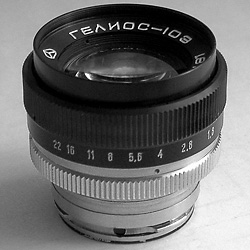
If one look at specifications of this lens (see table 1) he can see that it must have been a little bit
better than its predecessor Jupiter-8M. And actually it creates more sharp images. To confirm this statement
I took test pictures of one scene -
fog in March forest.
Both shots were made at aperture f/4 on the same film, were scanned together and their black and white point levels were corrected in Photoshop using the same numbers. Noise which appeared during scan procedure I did not correct to minimize the impact to the original quality of the photo. Who can afford to download large files of scanned photos of each lens may do it using links under the pictures.
For those who can not afford or have no wish to spend time and money there are six the most characteristic fragments (three from each photo) below for comparison. The first pair is from the upper left corner, the second pair is from the center and the third one is from the upper right corner.
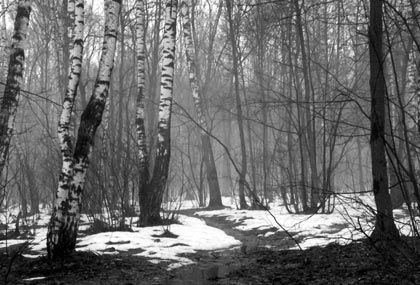 |
|
| Jupiter-8M, full-scaled photo (file size is 1Мб!)
Helios-103, full-scaled photo (file size is 1Мб!) |
|
| Fragments of photos took using the lens | |
| Jupiter-8M: | Helios-103: |
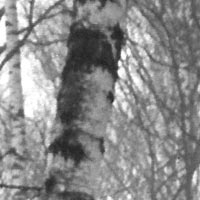 |
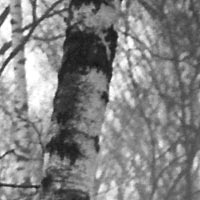 |
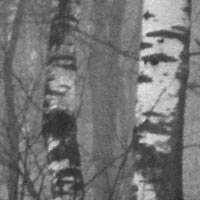 |
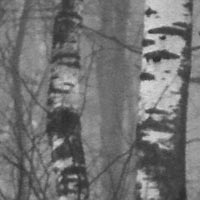 |
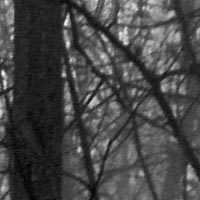 |
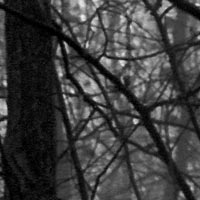 |
It is obviously that Helios-103 provides more sharpness and contrast than Jupiter-8M.
Moreover,
Jupiter-11 1:4 f=135mm
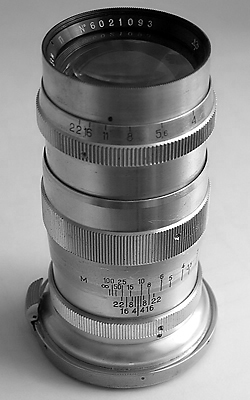
Shooting at apertures f/4...f/5.6 at distance
If at these apertures you shoot at distances about 10 m you simply receive good sharpness
Shooting without a tripod with shutter speeds 1/50 s and longer gives blur in more than half shots. This is wide-known problem of long focal
length: the longer, the more exacting to stability. There is a rule of thumb for finding the longest shutter speed without a tripod.
The denominator should be equal or more than focal length of the lens, i.e. for Jupiter-11 it is 1/125 s (a bit more than the exact value 1/135).
Certainly, if you ran before shooting several miles or drunk a bottle of vodka, blur will be even at 1/500 s, but for regular cases this rule is applicable.
Jupiter-12 1:2.8 f=35mm
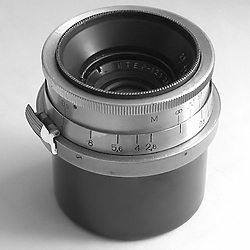
This wide-angle lens looks like an iceberg.
Another one noticeable pecularity of this lens is vignetting at open apertures.
Additionally I encountered with flare in the center of a negative if the light source was in radius of half a frame diagonal from the center (for example sunset or sunrise scenes with the Sun within the frame borders). This flare copy the form of five-bladed diaphragm. So, generally speaking, the lens has tendency to "catch flares" in the back or side-back light. And also in scenes like snowy landscape (even on cloudy day) or a placid lake in the foggy morning when the sun did not rise from the forest. These flares have mean blue shade and place near the center of the negative.
As practice shows, lenses made by LZOS (Lytkarino plant for the optical glass) more then others incline to this kind of sabotage. If you have such ability, it is better to find KMZ (Krasnogorsk mechanical plant) specimens of the lenses. In the Internet you can find the useful qualifier of USSR optical plants (in Russian) by their logos.
But if you think that the only you can do is to throw away your LZOS lens with scratched rear glass you make a mistake. It can be used for creating wonderful wide-angle monocle. By the way, when I dissected Jupiter-12 for this purpose I found the reason why it loves flares. And I found the simple and effective antidote. You may read about this in the paragraph dedicated to the monocle improvement.
As far as imaging chracter is concerned, I must say about well-known pecularity of all wide-angle lenses:
intensive perspective distortion. The shorter focal length the more pronounced perspective slopes of picture lines. The best object to see it is
architecture. Right angles and palalel lines allow reveal any distortion. There are two photos of one church below which were taken
using Jupiter-12 and Jupiter-8M from the same point. Optical axis of lenses were not horizontal to capture the whole church.
This, actually, results in perspective distortion because pictures were taken at rather close distance (about one height
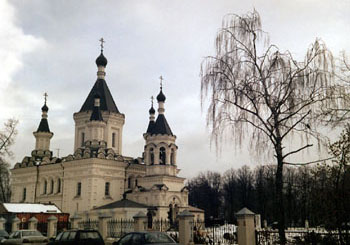 |
| Jupiter-12 lens |
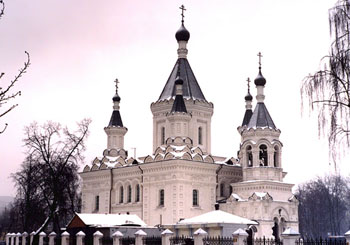 |
| Jupiter-8M lens |
Thus, in case of architectural scenes shooting one should use wide-angle lens with much care, but for example if it is used for taking picture of a road going far away or other scene where the perspective should be emphasized it will serve at its best.
Jupiter-9 1:2 f=85mm

This lens is intended first of all for portrait shots. It creates very nice soft picture - that is needed for this genre.
My experience shows that at aperture f/2.8 a face captured at 2 m is sharp enough
If, othewise, at the distance close to minimal you want to capture rather long object sharp you will encounter with problems. For example the bunch of flowers captured from 1.3 m is not the whole in depth of field at f/5.6 (see photo 2 - 1/5 s, f/5.6, 200 ISO). You should choose apertures f/8—f/11 or place the object farther.
Work at distances of several meters and more has no pecularities - everything is as for many other lenses.
 |
 |
| Фото 1 | Фото 2 |
Jupiter-3 1:1.5 f=53mm
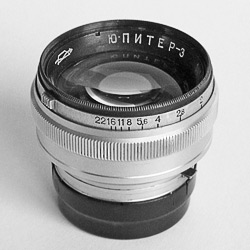
At the moment Jupiter-3 is the last lens for "Kiev" I have got. Both optical efficiency and 13-bladed diaphragm are its very attractive features of the lens. Such diaphragm construction promises soft and nice picture in the blur area — so-called bokeh.
And this is in the reality. Test shots shew that even in case of very difficult objects such as grass or branches Jupiter-3 created the least
disgusting picture in the blur area. The most unattractive standard lens to this effect is Helios-103 which was disscussed above.
However, everything should be paid for. In the case of Jupiter-3 the payment is the less resolution at the edges of the frame
(see table 1) and the less DOF. This means that each focusing miss results in waste shot.
The shots made using the aperture values from f/5.6 upto f/22 have no significant difference with photos taken by Helios-103 or Jupiter-8M.
The image quality comparison for all three 50-mm lenses is given on the following photos. From left to right: Helios-103, Jupiter-8M, Jupiter-3. Photo 1 was shot at the maximum aperture (f/1.8; f/2; f/1.5, accordingly), and the Photo 2 at the f/5.6. The rangefinder was aimed to the eye of the dinosaur. One can see that Jupiter-8M missed and should be adjusted: the most sharp object is the hip instead of the eye. And at the aperture f/5.6 focusing miss is noticeable. Other lenses hit the eye.
 |
 |
| Photo 1 | Photo 2 |
Depth of field and focusing accuracy at max aperture
To check depth of field and focusing accuracy at max aperture and minimal distance I took pictures of screws shown below.
Screws are in every house and can be a kind of rough test objects to check sharpness and contrast of a lens. Something like very rough pattern.
The purpose of the experiment is to find which depth of field and focusing accuracy provides each lens in described conditions. The central screw was
at such distance from the film surface which is determined as minimal for the lens in the table 1. Screws on the left side
were farther with the step of 5 cm and screws on the right side were closer
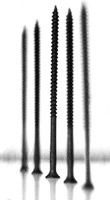 |
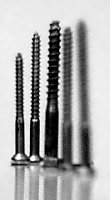 |
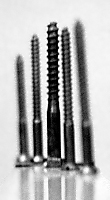 |
| Jupiter-3, f/1.5 | Jupiter-8M, f/2 | Helios-103, f/1.8 |
 |
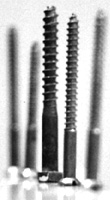 |
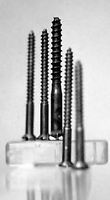 |
| Jupiter-12, f/2.8 | Jupiter-9, f/2 | Jupiter-11, f/4 |
You can see that Jupiter-8M has focus shift to farther side in these conditions. If the miss is not great it is not bad adjustment it is the feature of this type of lens (Jupiter-8 is a copy of Carl Zeiss pre-war Sonnar as well as Jupiter-3, Jupiter-9 and Jupiter-11).
The point is that at max aperture sphefical aberraion became significant. Spherical aberration causes parallel light rays passing through the edge of a lens to converge at a focal point closer to the lens than light rays passing through the center of the lens. There is nothing you can do with this only get used to. And make a correction of focus. However, in my case focus shift is too great, so, the lens have to be adjusted. Focusing of Jupiter-3 and Helios-103 is more accurate (its optical type is Planar), and wide-angle Jupiter-12 as well as portrait Jupiter-9 have small focus shift closer to the camera. Telephoto lens Jupiter-11 works without focus shift.
After such primitive test of you new-bought old lens you may get a conclusion whether it is needed to adjust it or not. Taking into account focus shift theoretical calculations of the DOF (you can find a lot of DOF calculators in the Internet) are in good correspondence with test photos.
Vignetting
Vignetting is insufficient lighting of the picture edges due to different optical obstacles on the rays path through the lens. More accurate description of the phenomenon sounds like that: "partial darkening of light beam entering into the optical system which appears due to its decreasing by the device diaphragm. Vignetting results in gradual picture lighting decreasing from the center to the edge of the view area." And another one: "Vignetting plays the significant part in photographic lenses. Usual it is no more 30-40% but in wide-angle lenses it can reach 50-60%, and this results in underexposure of the photographic plate edges." (Tudorovskiy A. I., Optical devices theory, part 1, 1948; Mandelshtam S. L., Introduction into the spectral analysis, 1946.)
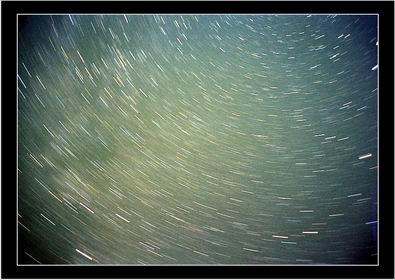 |
| Vignetting of Jupiter-12 at f/2.8 |
The example of Jupiter-12 vignetting at max aperture f/2.8 is given on the photo of the sky in the night.
Exposure was 20 minutes, during this time stars left bright traces on the whole picture area except for the corners. This darkening in the corners
caused by vignetting - the most part of rays from stars in these areas did not reach the film. Thus, the max aperture can be used only
in case of emergency, when no other options are available (first, I mean stopping down the lens). Surely, vignetting inheres not only this lens
What to read about "Kiev-4" camera